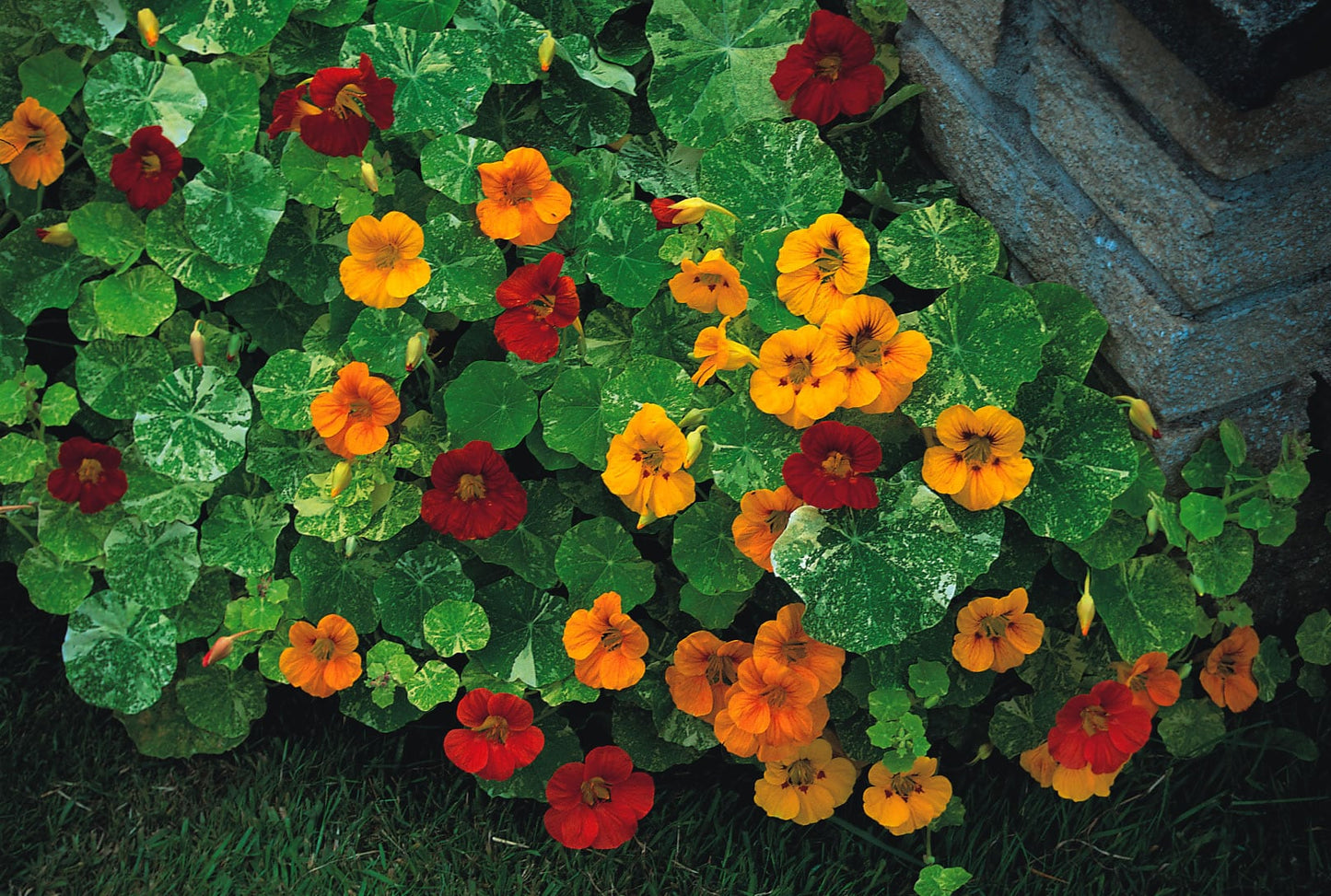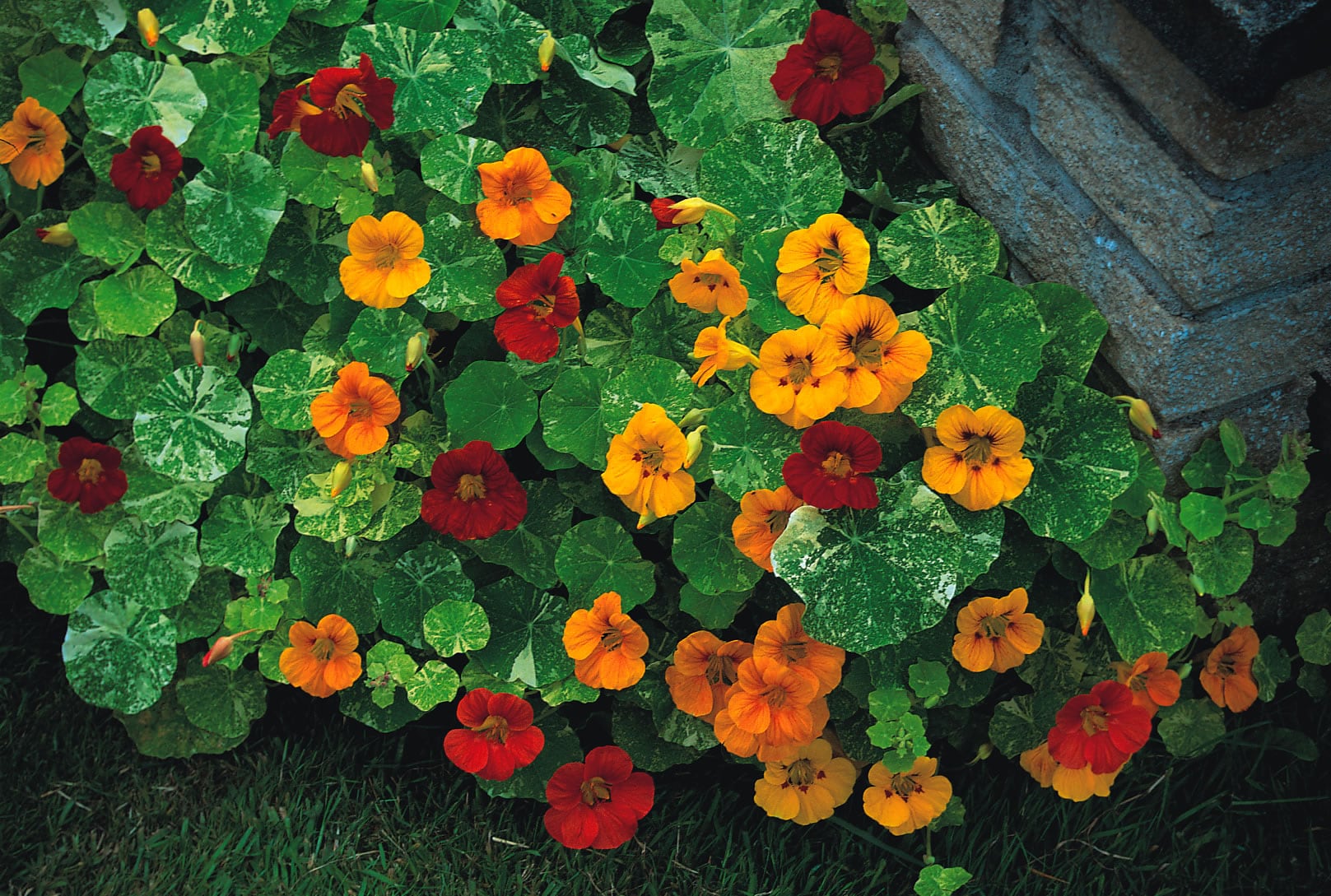Nasturtium Tom Thumb Alaska
Nasturtium Tom Thumb Alaska
Packet Size: 20 seeds
Couldn't load pickup availability
The marbled leaves of Nasturtium ‘Tom Thumb Alaska’ make a striking contrast to its rich red flowers. Perfect for growing among your veggies or in a greenhouse, it offers edible flowers, leaves, and seeds. And there’s plenty more nasturtium goodness and garden benefits to discover below.
🌸 Flowering: June to September
📏 Height: 30cm
🌿Annual
SOW: start seeds under cover in pots or modules about 2cm deep during February or March. Or sow them directly where you want them to flower in April or May. If you start them in pots, make sure to harden them off before planting out.
GROW: nasturtiums like free-draining soil and actually do better in poor soil. Too much rich compost or feeding will just give you loads of leaves and fewer flowers. For containers, try using low-nutrient seed compost when planting. Keep them watered regularly until they’re settled, then they pretty much look after themselves.
ENJOY: add the peppery flowers and leaves to salads, or stir chopped petals with mayo or yogurt dips. Pickle the immature seeds like capers. Nasturtium ‘Tom Thumb Alaska’ is as tasty as it is pretty — and great to have growing alongside your veggies or in your greenhouse. There’s plenty more to discover with this easy, useful, and colourful plant.
📌USES
Wildlife-friendly
- Bumble bees love the sweet nectar and get a generous dose of pollen
- Listed by the RHS as a pollinator-friendly plant
- A food plant for the Green-Veined White butterfly
- Predatory insects (the kind that help control pests) are drawn to the flowers too
- Nasturtium leaves hold water droplets — a handy drink and wash spot for butterflies and other insect visitors.
Edible:
- Flowers (the petals are the tastiest part) have a peppery kick — scatter them on salads or chop into dips with yogurt or mayo.
- Leaves have a spicy, watercress-like flavour. Use small amounts fresh in salads or dry them to make a colourful, peppery homemade seasoning salt
- The plump immature seeds can be pickled. They’re rich in oxalic acid, so best eaten in moderation.
Garden:
- Works well as a sacrificial plant in the veg patch — attracts blackfly off your beans and lures caterpillars from brassicas, especially later in the season.
- Rarely eaten by slugs and snails.
- Too much feed or water = all leaf, no flowers — keep it lean for best results.
- Makes a great ground cover, helping to retain moisture and suppress weeds.
- Attracts beneficial insects and gives off natural chemicals that help deter whitefly, beetles and other pests — protecting both itself and nearby crops.
- Said to benefit apple trees too — we find it adds a splash of colour in the dappled light, even if the science is still unclear.
Historical:
- The whole plant was eaten by the Incas
- Early English herbalists called it “Indian cress” — found and brought back from Peru and Mexico by conquistadors in the 16th century.
- Planted at Versailles for Louis XIV.
- Gained popularity as food and tea in Europe via the Orient.
- Nasturtiums reached North America with European settlers in the 1700s.
Other:
- Safe for rabbits, guinea pigs, and other small pets — flowers, leaves, stems, and seeds.
- Seeds can attract mice in the garden
- Used by Incas and native South Americans for its antibacterial properties; later eaten in Europe to treat urinary infections.
- In Victorian floriography (language of flowers), nasturtiums symbolised conquest, victory, and patriotism.
- Flowers and leaves contain vitamin C - once eaten to help prevent scurvy.
- The Vitamin C content might help to explain why many health claims have been made — but there’s no scientific evidence or clinical trials to back them up.
- Please Note: we do not promote the medicinal use of plants – guidance and information should be sought elsewhere.
Suits:
- Vegetable gardens, greenhouses & polytunnels
- Ground cover for moisture retention
- Edging
- Companion planting & sacrificial planting
- Wildlife-friendly gardens
- Cottage-style or informal planting
- Gravel or courtyard gardens

Collapsible content
Sowing
- Feb
- Mar
- Apr
- May
Harvesting / Flowering
- Jun
- Jul
- Aug
- Sep

